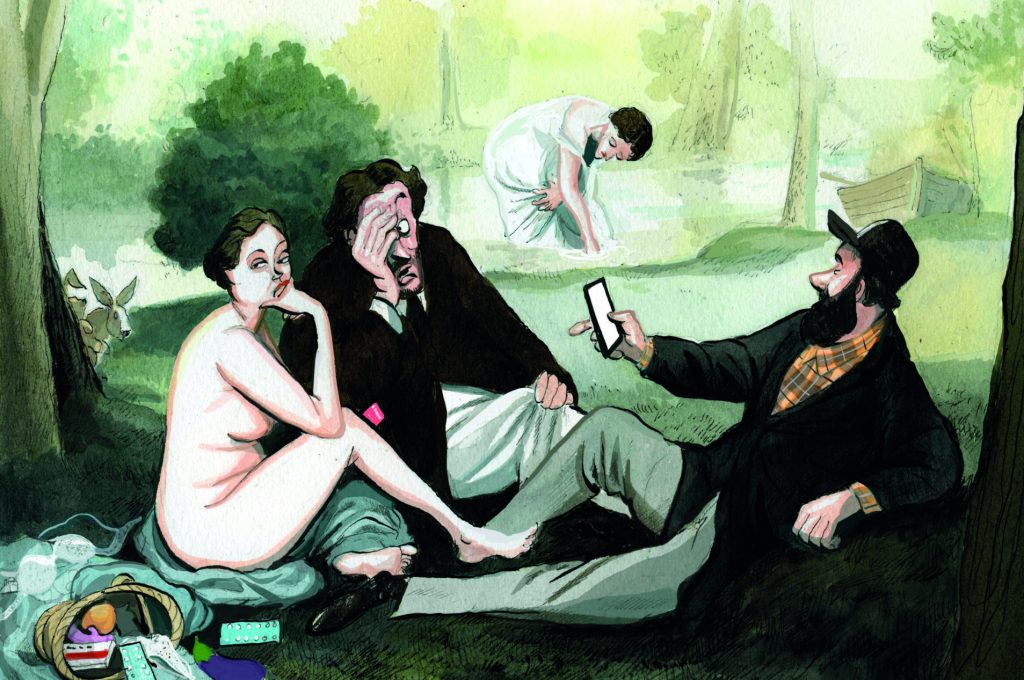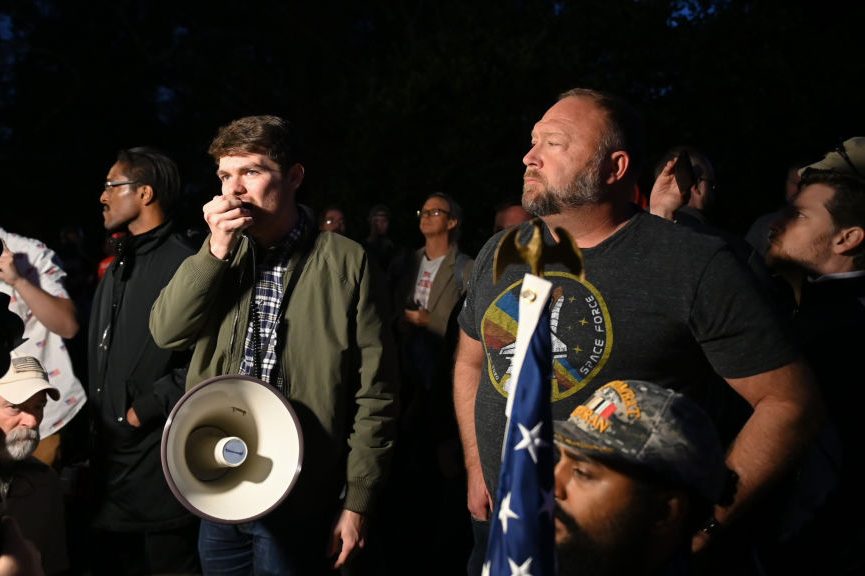This article was originally published in The Spectator’s June 2021 World edition.
Charlotte is a 23-year-old Harvard graduate. Beautiful and willowy, she grew up in — her words — ‘a super-liberal environment’. You might expect to find her Instagram full of sexy, pouting pictures. But Charlotte has deleted all the bikini photos from her online life. And six months ago, she embraced ‘modest dress’: nothing that exposes her collarbones or shoulders and nothing that reveals her legs above the knee.
Narayan is seven years older than Charlotte. He is what matchmaking 18th-century matrons might have described as ‘very eligible’: a clean-living, highly educated and charismatic single guy with a well-paid job in tech. He’s the embodiment of Jane Austen’s famous observation that ‘a single man in possession of a good fortune, must be in want of a wife’. And contra all the modern laments about single men preferring to play the field, Narayan actually wants to get married.
Narayan and his close male friends are all around the same age. They’re all elite guys working in tech and finance — and all either dating to marry, or already married. In what amounts to an informal 21st-century marriage brokerage, they and the wives of already-married members of their friend group collude to track down potential partners. But they’re picky — and Narayan is blunt about the criteria. It’s not just about being educated, ambitious or pretty. ‘Guys who say they don’t care about their wife’s sexual history are straight-up lying,’ he tells me. All the men in his group, he says, would strongly prefer their future wives to be virgins on marriage. Some categorically rule out women who aren’t: ‘No hymen, no diamond’.
Charlotte and Narayan are not the uptight fundamentalists or ugly, embittered feminists of stereotype: they’re members of the Ivy-educated jeunesse dorée. They’re pushing back against a culture of sexual freedom they see as toxic not just to individual wellbeing, but even to the long-term health of American society. They’re the forefront of what ‘Default Friend’, a Bay Area writer on sex and relationships, terms ‘the coming wave of sex-negativity’.
Welcome to the sexual counterrevolution.
The current they’re swimming against is strong. Charlotte reports that, when she got engaged in her senior year at Harvard, her peers looked at her ‘like I was crazy’ for expressing a preference for children over a high-flying career. Narayan tells me that his views on the importance of marriage and the qualities he seeks in a potential spouse have left him facing accusations of woman-hating.
‘Voicing any of this stuff openly is just social suicide,’ he says. So much so, in fact, that ‘Narayan’ is a pseudonym: there’s simply no way he can afford to be quoted about this under his real name without risking social censure or even repercussions at work.
Consider that for a moment. A 30-year-old American man holds the (until recently entirely conventional) opinion that men and women should refrain from promiscuity and that marriage, monogamy and family life are general social goods. And he will say so only under a pseudonym, for fear of destroying his career.
How did we get here? There have been multiple attempts at sexual revolution in America but, prior to the availability of reliable birth control, all failed to gain widespread traction. It’s not as though an unplanned pregnancy can be shared equally by both parties; historically the parent left holding the baby was most often the woman.
Under those conditions, Americans developed elaborate social codes to manage contact between horny young people — and to channel sexual desire toward commitment and child-rearing. In 17th-century New England, unmarried couples were strictly chaperoned, but the promenading Puritans were given a ‘courting stick’: a long, hollow tube they could use to whisper sweet nothings to one another. When a couple was close enough that marriage was expected, they were permitted to spend the night together – but with the woman clothed in a tight nightdress that rendered her (as it were) inaccessibly mermaid-like below the waist.
Less eccentrically, in A Young Lady’s Friend (1837), Mrs John Farrar advises young ladies to preserve ‘delicacy and refinement’ by never squeezing into tight spaces with a man, taking an unaccompanied carriage ride with one, or even holding a man’s hand. Such proscriptions aimed at foreclosing the possibility of physical contact, let alone anything more intimate.
In 1960 the FDA approved the first birth control pill. Abruptly, women’s most compelling motivation for not accepting an unchaperoned carriage ride fell away — and women rejoiced. Cosmopolitan editor Helen Gurley Brown’s influential Sex and the Single Girl (1962) argued that women have as much right to sexual pleasure as men and offered women advice on developing an active sex life before marriage. In her radical feminist manifesto The Dialectic of Sex (1970), Shulamith Firestone responded to new developments in reproductive technology by imagining ‘the freeing of women from the tyranny of reproduction by every means possible’ so that ‘humanity could finally revert to its natural polymorphous sexuality’ in which ‘all forms of sexuality would be allowed and indulged’.
Firestone envisaged a utopia in which all forms of sexuality could flourish in freedom. Since her heyday, the progressive world has near-unanimously championed sexual liberation and openness as a crucial emancipatory cause. That ‘Narayan’ is only willing to criticize this consensus under a pseudonym attests to how decisively that battle has been won.
But what kind of victory has it been? Firestone dreamed of unmooring desire from reproduction in the interests of a joyfully sensuous new world. In practice, though, desire was no sooner emancipated than it found itself pressed into service again: first to sell entertainment or consumer goods and, increasingly, as the product itself. In the process, the idea of female empowerment has gradually fused with the demands of the market.
Helen Gurley Brown celebrated liberation from the risk of pregnancy by advising women to ‘get to a man by dealing with him on his professional level, then stay around to charm and sexually zonk him’.
But the dividends of America’s burgeoning sexual freedom didn’t go only to women who embraced this blend of professional and sexual aggression. In 1960, the year the FDA approved the Pill, Hugh Hefner opened the first Playboy club in Chicago. By the end of 1961, Hefner’s Chicago club was the busiest nightclub in the world — with the role of ‘Playboy bunny’ marketed to young women as a glamorous and high-earning occupation.
By 1998, this convergence of sex, commerce and feminism had its own smash-hit TV drama, Sex and the City. Its high-achieving, sexually voracious thirty-something female characters glamorized the ideal that leveraging your sex appeal for power and pleasure was feminism. In its first episode, Carrie, the lead protagonist, uses a man for sex and reports ‘feeling powerful, potent and incredibly alive’.
To the victor, the spoils. Since 1998, pop-feminism has largely been concerned with setting acceptable boundaries for male responses to women’s sexual self-expression and rendering any holdout bastions of prudishness unacceptable in polite society. The ‘Slutwalk’ and #MeToo movements entrenched as orthodoxy the view that women can and should dress and behave as they please, without any fear of unwanted sexual attention. And the ‘sex-positivity’ movement painted tolerance of diverse sexual practices and preferences as a key social-justice issue. ‘Don’t yuck my yum,’ advises ‘sex educator’ Pamela Madsen in Huffpost.
Over the same half century, the pornographic empire that made Hugh Hefner a multimillionaire mushroomed into a $3 billion internet industry in America alone and accounts for some $97 billion worldwide. Pornhub alone is valued at over $1 billion. And OnlyFans, a website which allows ‘creators’ to sell their own pornographic images to ‘fans’, now boasts one million (mostly female) creators worldwide and over 30 million (mostly male) users.
Pornography is now a key plank of feminist empowerment, championed by ‘sex-positive’ activists under the slogan ‘Sex work is work’. This year, Ohio State University’s ‘Sex Week’ included classes for undergraduates interested in starting an OnlyFans. At the Grammy Awards in March, Cardi B and Megan Thee Stallion’s performance of their smash hit ‘WAP’ rejoiced in the artist’s power to make men ‘pay my tuition just to kiss me on this wet-ass pussy’. What began with the Pill, Cosmopolitan and Playboy has ended with feminism, desire and commerce indistinguishable from one another.
This fusion of sex and business has performed a reverse takeover of relationship formation in what is now called the ‘sexual marketplace’ — a term unheard before 1960 but now commonplace. And with sex thus subject to market logic, the main consideration in arranging it — as in any other transaction — is that both parties agree to the deal.
But the relationship between sex and ‘consent’ has long been ambiguous. One veteran of the sexual revolution, the British journalist Virginia Ironside, wrote of life as a young woman in the 1960s:
‘With every man knowing you were armed with the pill, pregnancy was no longer a reason to say ‘no’ to sex… I mainly remember the 60s as an endless round of miserable promiscuity, a time when often it seemed easier and, believe it or not, more polite, to sleep with a man than to chuck him out of your flat.‘
Half a century after Ironside ‘consented’ out of politeness to sexual encounters that she neither wanted nor enjoyed, women consent to considerably more. One outcome of the ‘sex-positive’ drive that reframes shame as oppression has been to render taboo the expression of any disapproval of another person’s erotic preferences. In progressive online youth cultures this is known as ‘kink-shaming’ and is a serious faux pas.
At the same time, though, growing numbers of young women are taking to social media to recount experiences of abuse perpetrated under the guise of ‘kink’. ‘Smokinfeds’, a young Twitter user, describes how, when she was a teenager, the 38-year-old man with whom she had a ‘consensual’ BDSM relationship introduced ‘breath play’: ‘he was piss drunk & put me in a rear naked choke & I passed out.’ On another occasion, she recounts, ‘I’d woken up to him shoving crushed up Adderall in my vagina.’
Louise Perry, 29, is a co-founder of ‘We Can’t Consent To This’, a British campaign against sexual violence. The campaign’s #WeCantConsentToThis hashtag has gained traction internationally as an online focal point for women with shocking stories of sexual violence, often experienced at a startlingly young age. Perry lists more than 60 cases of women killed since 1972, supposedly during ‘rough sex gone wrong’: victims who, before they died, had experienced violence including waterboarding, wounding, strangulation, beating and asphyxiation — acts to which they had, supposedly, consented.
In her forthcoming book on the sexual revolution, Perry argues that pornography is normalizing such abuse. Studies support this. A 2018 study of American youth identifies exposure to violent pornography as a key risk factor for engaging in real-life sexual aggression. Similarly, a British survey from 2020 finds that 71 percent of men under 40 have slapped, choked, gagged or spat on a partner during sex, with 51 percent indicating that pornography had influenced their desire to do so.
Pornography, Perry claims, is also degrading young people’s capacity for mutual pleasure. One young woman posts on Reddit’s relationships board about how her boyfriend can only reach climax by watching ‘blueberry porn’, a niche subgenre inspired by Charlie and the Chocolate Factory, in which women turn purple and become grotesquely inflated. Another poster complains that her relationship is faltering because her partner has desensitized himself through repeated masturbation to the point where he cannot orgasm at all — a phenomenon known among young men as ‘death grip syndrome’.
Aaron Sibarium, a 25-year-old American writer, describes this mercenary, violent and atomized libidinal landscape as ‘sexual disenchantment’ in which ‘free love’ becomes ‘a sterile spin-off of the market’. Perhaps unsurprisingly, this collective erotic ennui has coincided with what the Atlantic has called a ‘sex recession’. Between 1991 and 2017, the percentage of high-school students who’d had intercourse dropped from 54 percent to 40 percent. Today, people in their early 20s are twice as likely to be sexually abstinent as Gen Xers were at the same age.
The effects reverberate. According to the Institute of Family Studies, 26 percent of millennials aged 30-34 have not yet formed a family. This failure rate is double the 13 percent failure rate of the boomers at the same age. CDC data show that the American birth rate has been consistently below replacement since 2007 — something even the most liberal commentators acknowledge will have profound long-term economic and political consequences.
‘Default Friend’, the California writer, reports that marriage now seems so out of reach for the young men who write to her for advice it’s no longer perceived as stuffy and conventional but ‘a status thing’. In pursuit of that elusive goal, some are taking matters into — or rather, out of — their own hands. Unlike the 19th-century drive for ‘continence’, the anti-masturbation move- ment known as ‘#NoFap’ is driven not by doctors and parents but by young men. The 800,000-strong, 99 percent-male member- ship of the r/NoFap subreddit continually express their longing for real-life intimacy. They describe their chances of finding and forming relationships as profoundly damaged by habitually high levels of porn consumption. Success posts often cite finding a girlfriend as evidence of the transformative power of quitting.
On the other side of the looking glass are the young women who produce the images in question. They are encouraged by a nakedly commercial understanding of ‘sex-positivity’, and to view themselves as empowered entrepreneurs, not entry-level pornographers. Charlotte sees this as a toxic lie, as likely to undermine the prospect of real intimacy for the women who embrace it as compulsive masturbation is for men. ‘We have to ask ourselves: would I be the guy who’d marry the OnlyFans girl?’ For her, modesty offers a more lasting path to empowerment. ‘Being sexy is a huge dopamine rush,’ she explains, ‘but real feminism is about being able to develop an identity that’s bigger than just biology.’
Out there in the sexual marketplace, anything still goes. ‘Everybody’s relationship with sexuality, gender and romance is simply their own,’ Pamela Madsen asserts. Narayan disagrees. It’s not just about whether it’s OK to ‘yuck’ someone’s ‘yum’, he argues, when sexual disenchantment is ‘killing the West’. He sees the stakes as existential: ‘Civilization is going to fall apart if people can’t have families.’
No culture is monolithic. Feminism produced Helen Gurley Brown and Sex and the City; it also produced Phyllis Schlafly and Andrea Dworkin, two women from opposing ends of the political spectrum but both early critics of America’s burgeoning culture of sexual freedom. Are ‘sex-negative’ voices like Charlotte and Narayan just a contrarian minority?
‘Default Friend’ thinks not. ‘People are burned out,’ she says. As one male TikTok user recently put it: ‘I used to love ass gazing,’ but ‘y’all have shown me so much ass I’m numb to it.’ His advice? ‘Just keep it in your pants, man.’ ‘Default Friend’ points out that by the time a cultural shift becomes visible in online discourse, it’s already well-established: ‘The sex-negativity thing has been simmering for a long time,’ she says, ‘but now the house is burning down.’
She’s speaking figuratively. But on April 25 this year Feras Antoon, one of the founders of Pornhub, saw his $20-million Montreal mansion burned to the ground in what appears to be an arson attack. Commentators were quick to insinuate a link between this event and the ‘Exodus Cry’ anti-porn campaign, from a group the Daily Beast called ‘a shady Evangelical group with Trump ties’. Despite what this might imply about the religious and political affiliations of those hostile to the porn industry, American faith has been in freefall for a long time. In the last decade alone, Pew reports, the proportion of self-identifying American Christians has fallen by 12 percent — yet the campaign against Pornhub has mushroomed. Online supporters can be found not just on the religious right but among a broader coalition that includes radical feminists, former porn stars and growing numbers of young ‘kink’ survivors, #NoFap alumni and the sexually disenchanted.
When it comes to sexuality, the question is less how we can have it all than ‘what are we willing to trade?’ The sexual revolution sought to ease the burden of shame and social constraint — especially for women. Yet if we listen to its inheritors, the outcome has not been polymorphous pleasure but escalating degradation; not female erotic emancipation but violence masquerading as desire; not a garden of earthly delights but desensitization, loneliness and a collapsing birth rate.
The price of fusing empowerment and freedom with desire and commerce turned out to be human intimacy. The winners turn out not to be women, but porn barons like Feras Antoon. Now the counterrevolutionaries want intimacy back. If their numbers continue to grow, we may find that the price of victory is the death of sexual freedom. We may also discover that this proves as much a mixed blessing as its birth.
Mary Harrington is a columnist for Unherd. This article was originally published in The Spectator’s June 2021 World edition.

























